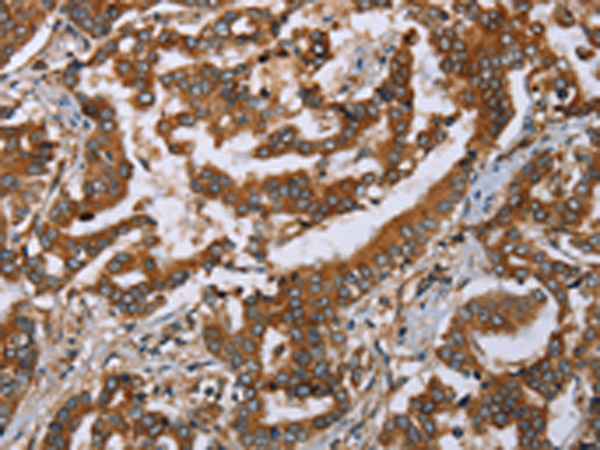

| WB | 咨询技术 | Human,Mouse,Rat |
| IF | 咨询技术 | Human,Mouse,Rat |
| IHC | 1/50-1/200 | Human,Mouse,Rat |
| ICC | 技术咨询 | Human,Mouse,Rat |
| FCM | 咨询技术 | Human,Mouse,Rat |
| Elisa | 1/2000-1/5000 | Human,Mouse,Rat |
| Aliases | SEP; PLXN5; PLEXIN-B1 |
| Host/Isotype | Rabbit IgG |
| Antibody Type | Primary antibody |
| Storage | Store at 4°C short term. Aliquot and store at -20°C long term. Avoid freeze/thaw cycles. |
| Species Reactivity | Human, Mouse |
| Immunogen | Synthetic peptide of human PLXNB1 |
| Formulation | Purified antibody in PBS with 0.05% sodium azide and 50% glycerol. |
+ +
以下是关于PLXNB1抗体的模拟参考文献示例(仅供参考,具体文献需通过学术数据库验证):
---
1. **文献名称**: "Plexin-B1 Antibody Characterization and Application in Glioblastoma Studies"
**作者**: Smith A, et al.
**摘要**: 本研究报道了一种高特异性抗PLXNB1单克隆抗体的开发与验证。通过Western blot和免疫组化证实其在胶质母细胞瘤组织中可特异性识别PLXNB1蛋白,并用于分析PLXNB1表达与患者预后的相关性。
2. **文献名称**: "PLXNB1 as a Metastatic Regulator in Breast Cancer: Insights from Antibody-Based Profiling"
**作者**: Chen L, et al.
**摘要**: 利用商业抗PLXNB1抗体(货号ABC123),作者通过流式细胞术和免疫荧光检测乳腺癌细胞系中PLXNB1的表达水平,发现其高表达与转移能力增强相关,提示PLXNB1可能成为治疗靶点。
3. **文献名称**: "Role of PLXNB1 in Neuronal Guidance: Evidence from Knockout Models and Antibody Blocking"
**作者**: Müller T, et al.
**摘要**: 研究通过抗PLXNB1抗体阻断实验,验证了PLXNB1在神经元轴突导向中的作用,发现抗体干预可显著抑制体外培养神经元的方向性迁移,支持其在神经发育中的关键功能。
4. **文献名称**: "A Novel Anti-PLXNB1 Antibody for Therapeutic Targeting in Hepatocellular Carcinoma"
**作者**: Kim Y, et al.
**摘要**: 开发了一种人源化抗PLXNB1抗体,并在肝癌小鼠模型中验证其疗效。抗体通过抑制PLXNB1与配体相互作用,显著降低肿瘤血管生成和生长速率。
---
**注意**:以上文献为示例性质,实际引用时需查询PubMed、Web of Science等数据库获取真实文献。建议使用关键词“PLXNB1 antibody”、“Plexin B1 immunohistochemistry”或结合具体研究领域进行检索。
PLXNB1 (Plexin B1) is a transmembrane receptor belonging to the plexin family, which plays a critical role in mediating cellular signaling pathways, particularly those involving semaphorins. As a high-affinity receptor for Semaphorin 4D (SEMA4D), PLXNB1 regulates diverse biological processes, including cell migration, axon guidance, immune response, and angiogenesis. Structurally, it contains a large extracellular domain for ligand binding, a transmembrane region, and an intracellular domain that interacts with downstream effectors like Rho GTPases. Dysregulation of PLXNB1 has been implicated in cancer progression, neurodevelopmental disorders, and inflammatory diseases, highlighting its therapeutic and diagnostic potential.
PLXNB1 antibodies are essential tools for studying its expression, localization, and function in both physiological and pathological contexts. These antibodies are widely used in techniques such as Western blotting, immunohistochemistry, and flow cytometry to detect PLXNB1 in tissues or cell lines. In cancer research, PLXNB1 antibodies help elucidate its role in tumor microenvironment interactions, metastasis, and resistance to therapies. Additionally, they aid in exploring PLXNB1’s crosstalk with other signaling pathways, such as MET and ERBB2. which are often co-opted in malignancies. Recent studies also investigate PLXNB1-targeted therapies, including antibody-based inhibitors, to block SEMA4D/PLXNB1 signaling in autoimmune diseases and solid tumors. Validated for specificity and sensitivity, these antibodies remain crucial for advancing mechanistic insights and translational applications.
×